Abstract
We demonstrate that familial hypertrophic cardiomyopathy (FHC), an autosomal dominant disorder of heart muscle, is a genetically heterogeneous disease. The locus responsible for FHC in members of one large kindred was recently mapped to chromosome 14q11-12 (FHC-1). We have characterized three additional unrelated families in which the gene for FHC segregates as an autosomal dominant trait to determine if these disease loci also map to FHC-1. All family members were clinically studied by physical examination, electrocardiogram, and two-dimensional echocardiography. Genetic studies were performed using DNA probes which are derived from loci that are closely linked to FHC-1. In one family the genetic defect maps to the previously identified FHC-1 locus. However, the loci responsible for FHC in two other families were not linked to FHC-1. We conclude that FHC can be caused by defects in at least two loci and is a genetically heterogeneous disorder.
Full text
PDF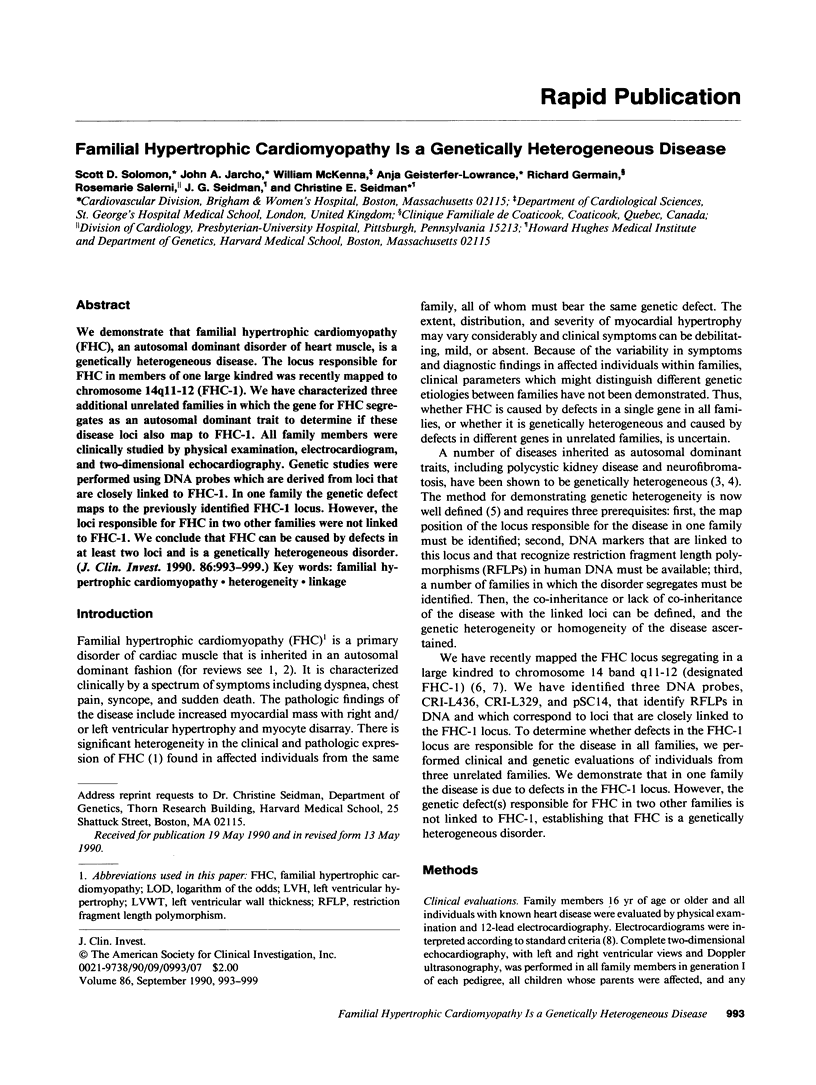
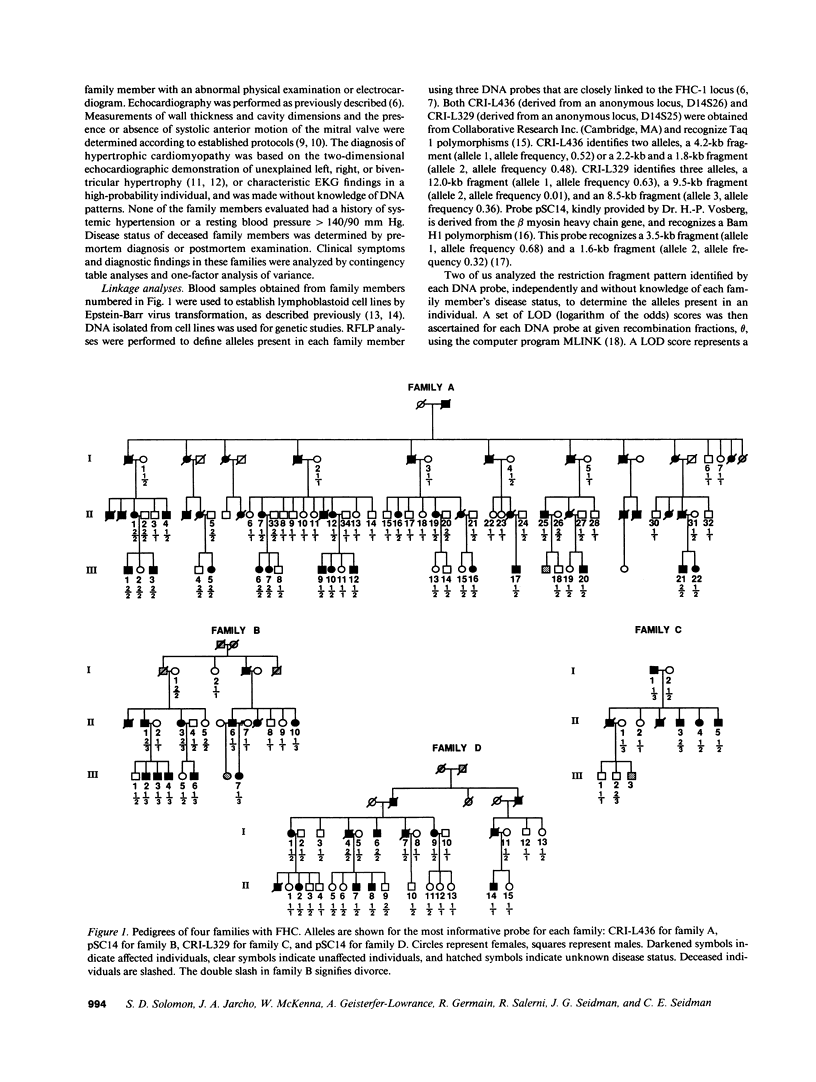
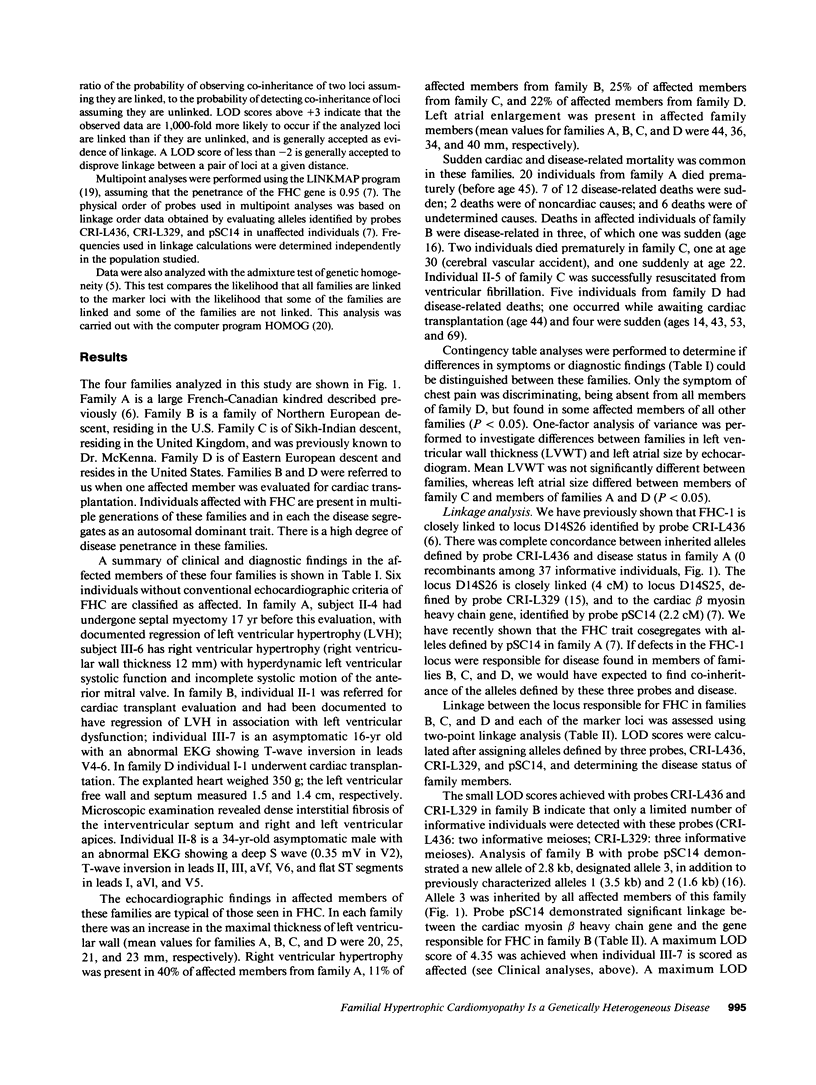
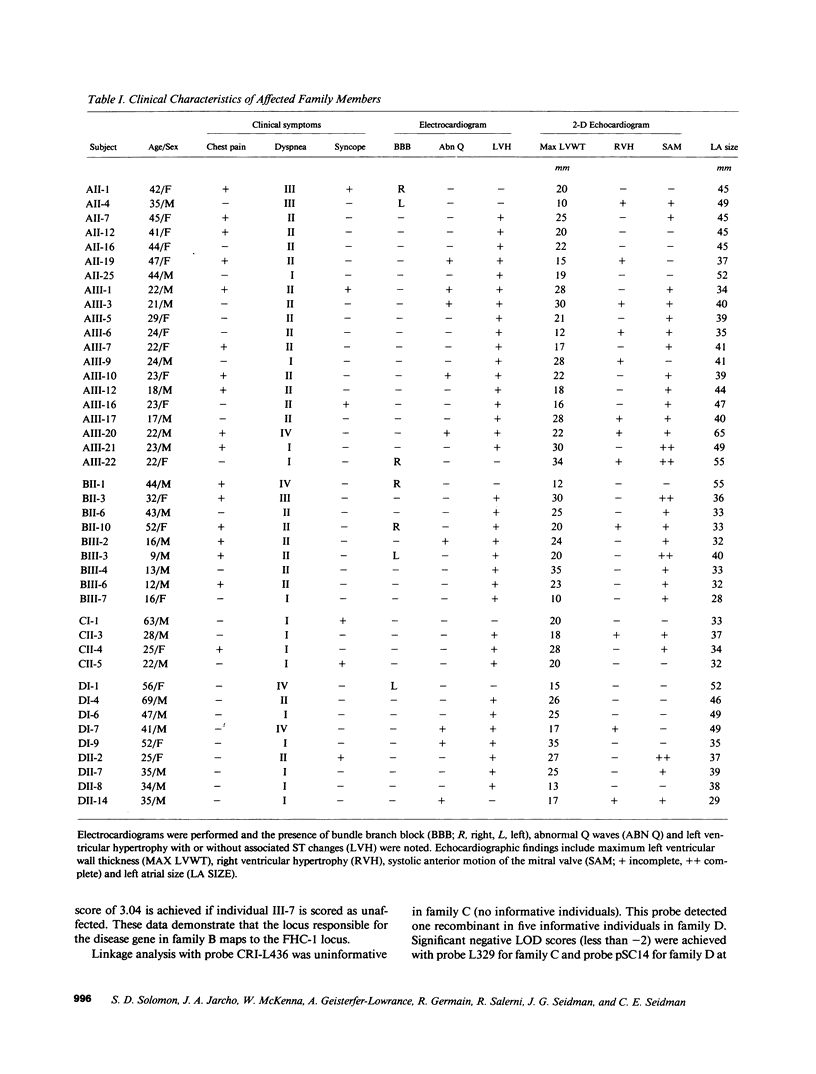
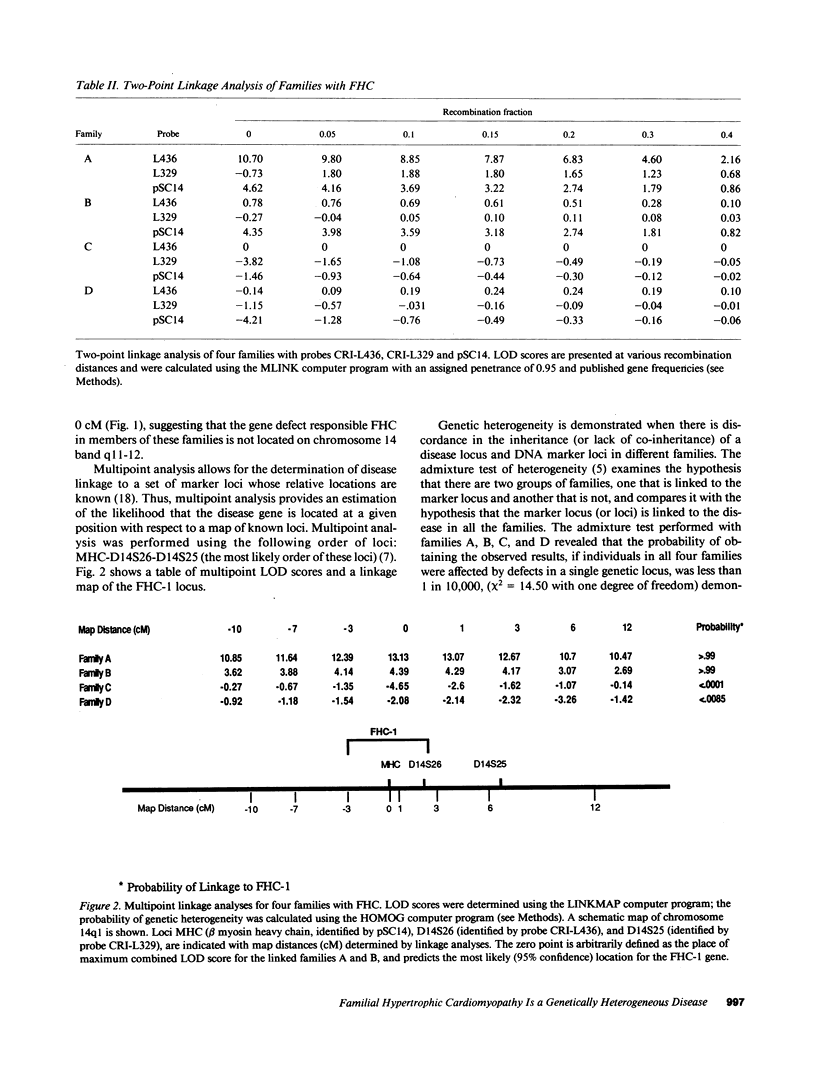
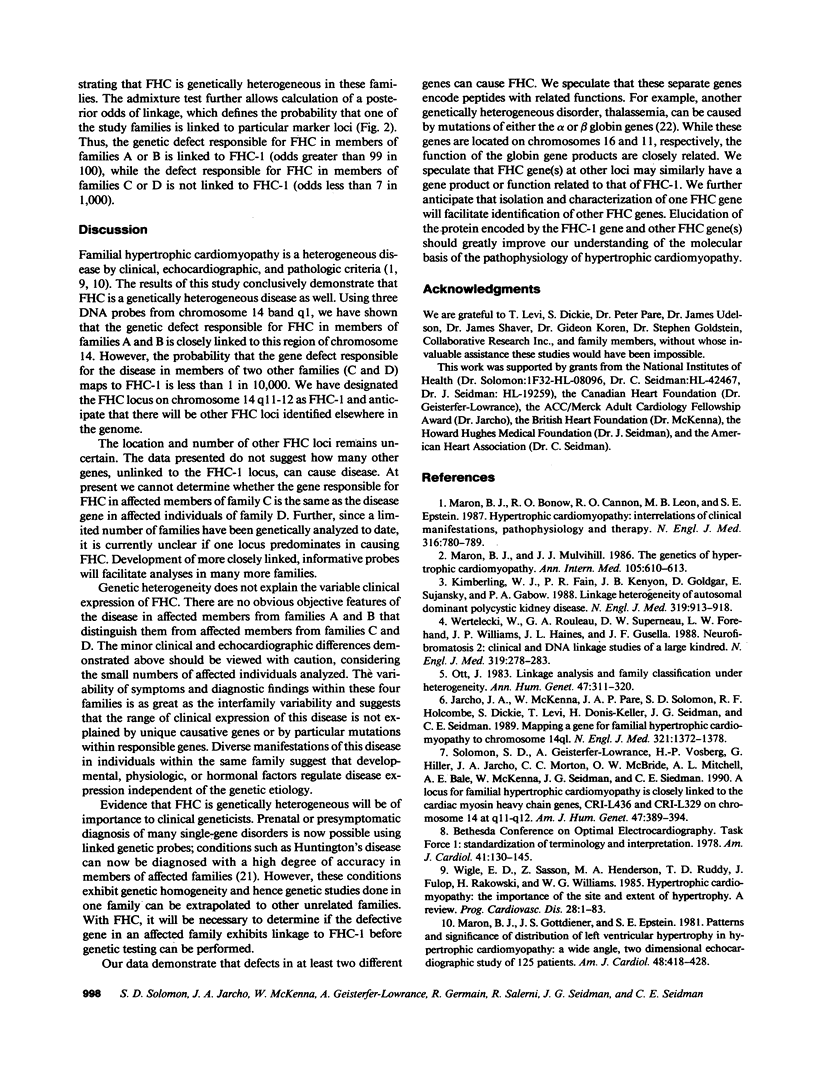
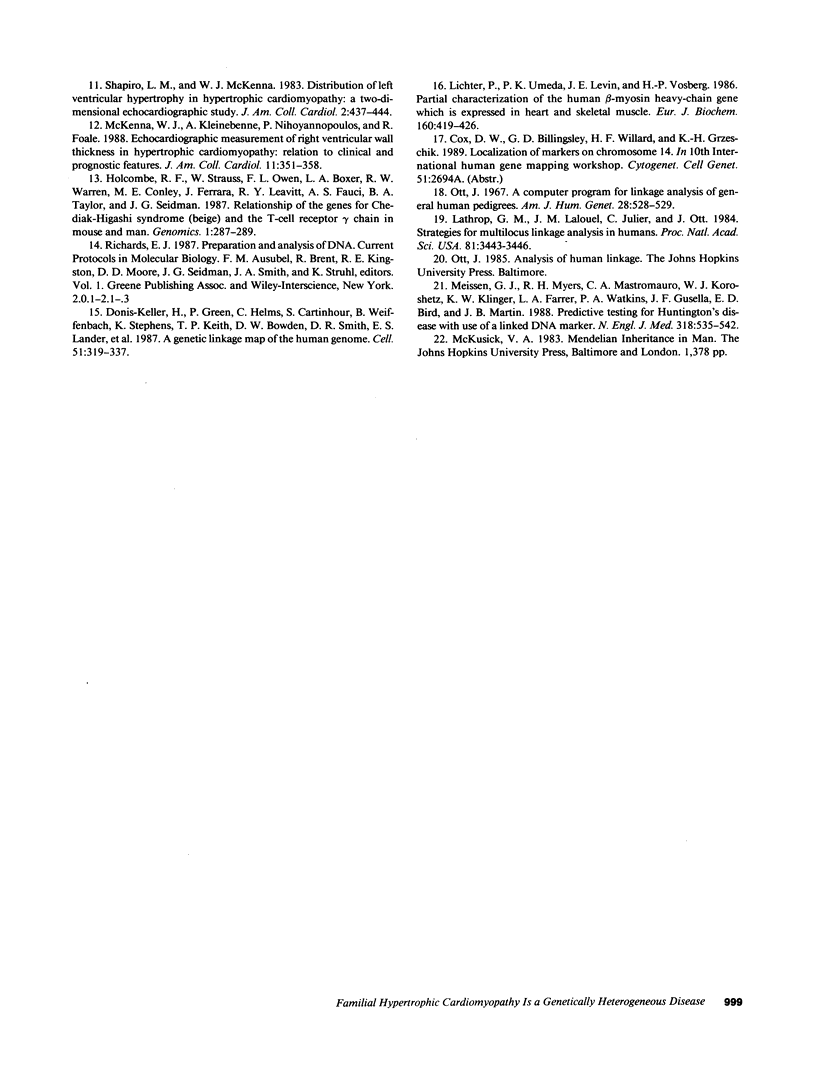
Selected References
These references are in PubMed. This may not be the complete list of references from this article.
- Donis-Keller H., Green P., Helms C., Cartinhour S., Weiffenbach B., Stephens K., Keith T. P., Bowden D. W., Smith D. R., Lander E. S. A genetic linkage map of the human genome. Cell. 1987 Oct 23;51(2):319–337. doi: 10.1016/0092-8674(87)90158-9. [DOI] [PubMed] [Google Scholar]
- Holcombe R. F., Strauss W., Owen F. L., Boxer L. A., Warren R. W., Conley M. E., Ferrara J., Leavitt R. Y., Fauci A. S., Taylor B. A. Relationship of the genes for Chediak-Higashi syndrome (beige) and the T-cell receptor gamma chain in mouse and man. Genomics. 1987 Nov;1(3):287–291. doi: 10.1016/0888-7543(87)90058-9. [DOI] [PubMed] [Google Scholar]
- Jarcho J. A., McKenna W., Pare J. A., Solomon S. D., Holcombe R. F., Dickie S., Levi T., Donis-Keller H., Seidman J. G., Seidman C. E. Mapping a gene for familial hypertrophic cardiomyopathy to chromosome 14q1. N Engl J Med. 1989 Nov 16;321(20):1372–1378. doi: 10.1056/NEJM198911163212005. [DOI] [PubMed] [Google Scholar]
- Kimberling W. J., Fain P. R., Kenyon J. B., Goldgar D., Sujansky E., Gabow P. A. Linkage heterogeneity of autosomal dominant polycystic kidney disease. N Engl J Med. 1988 Oct 6;319(14):913–918. doi: 10.1056/NEJM198810063191405. [DOI] [PubMed] [Google Scholar]
- Lathrop G. M., Lalouel J. M., Julier C., Ott J. Strategies for multilocus linkage analysis in humans. Proc Natl Acad Sci U S A. 1984 Jun;81(11):3443–3446. doi: 10.1073/pnas.81.11.3443. [DOI] [PMC free article] [PubMed] [Google Scholar]
- Lichter P., Umeda P. K., Levin J. E., Vosberg H. P. Partial characterization of the human beta-myosin heavy-chain gene which is expressed in heart and skeletal muscle. Eur J Biochem. 1986 Oct 15;160(2):419–426. doi: 10.1111/j.1432-1033.1986.tb09989.x. [DOI] [PubMed] [Google Scholar]
- Maron B. J., Bonow R. O., Cannon R. O., 3rd, Leon M. B., Epstein S. E. Hypertrophic cardiomyopathy. Interrelations of clinical manifestations, pathophysiology, and therapy (1). N Engl J Med. 1987 Mar 26;316(13):780–789. doi: 10.1056/NEJM198703263161305. [DOI] [PubMed] [Google Scholar]
- Maron B. J., Gottdiener J. S., Epstein S. E. Patterns and significance of distribution of left ventricular hypertrophy in hypertrophic cardiomyopathy. A wide angle, two dimensional echocardiographic study of 125 patients. Am J Cardiol. 1981 Sep;48(3):418–428. doi: 10.1016/0002-9149(81)90068-0. [DOI] [PubMed] [Google Scholar]
- Maron B. J., Mulvihill J. J. The genetics of hypertrophic cardiomyopathy. Ann Intern Med. 1986 Oct;105(4):610–613. doi: 10.7326/0003-4819-105-4-610. [DOI] [PubMed] [Google Scholar]
- McKenna W. J., Kleinebenne A., Nihoyannopoulos P., Foale R. Echocardiographic measurement of right ventricular wall thickness in hypertrophic cardiomyopathy: relation to clinical and prognostic features. J Am Coll Cardiol. 1988 Feb;11(2):351–358. doi: 10.1016/0735-1097(88)90101-5. [DOI] [PubMed] [Google Scholar]
- Meissen G. J., Myers R. H., Mastromauro C. A., Koroshetz W. J., Klinger K. W., Farrer L. A., Watkins P. A., Gusella J. F., Bird E. D., Martin J. B. Predictive testing for Huntington's disease with use of a linked DNA marker. N Engl J Med. 1988 Mar 3;318(9):535–542. doi: 10.1056/NEJM198803033180903. [DOI] [PubMed] [Google Scholar]
- Ott J. A computer program for linkage analysis of general human pedigrees. Am J Hum Genet. 1976 Sep;28(5):528–529. [PMC free article] [PubMed] [Google Scholar]
- Ott J. Linkage analysis and family classification under heterogeneity. Ann Hum Genet. 1983 Oct;47(Pt 4):311–320. doi: 10.1111/j.1469-1809.1983.tb01001.x. [DOI] [PubMed] [Google Scholar]
- Shapiro L. M., McKenna W. J. Distribution of left ventricular hypertrophy in hypertrophic cardiomyopathy: a two-dimensional echocardiographic study. J Am Coll Cardiol. 1983 Sep;2(3):437–444. doi: 10.1016/s0735-1097(83)80269-1. [DOI] [PubMed] [Google Scholar]
- Solomon S. D., Geisterfer-Lowrance A. A., Vosberg H. P., Hiller G., Jarcho J. A., Morton C. C., McBride W. O., Mitchell A. L., Bale A. E., McKenna W. J. A locus for familial hypertrophic cardiomyopathy is closely linked to the cardiac myosin heavy chain genes, CRI-L436, and CRI-L329 on chromosome 14 at q11-q12. Am J Hum Genet. 1990 Sep;47(3):389–394. [PMC free article] [PubMed] [Google Scholar]
- Wertelecki W., Rouleau G. A., Superneau D. W., Forehand L. W., Williams J. P., Haines J. L., Gusella J. F. Neurofibromatosis 2: clinical and DNA linkage studies of a large kindred. N Engl J Med. 1988 Aug 4;319(5):278–283. doi: 10.1056/NEJM198808043190505. [DOI] [PubMed] [Google Scholar]
- Wigle E. D., Sasson Z., Henderson M. A., Ruddy T. D., Fulop J., Rakowski H., Williams W. G. Hypertrophic cardiomyopathy. The importance of the site and the extent of hypertrophy. A review. Prog Cardiovasc Dis. 1985 Jul-Aug;28(1):1–83. doi: 10.1016/0033-0620(85)90024-6. [DOI] [PubMed] [Google Scholar]


